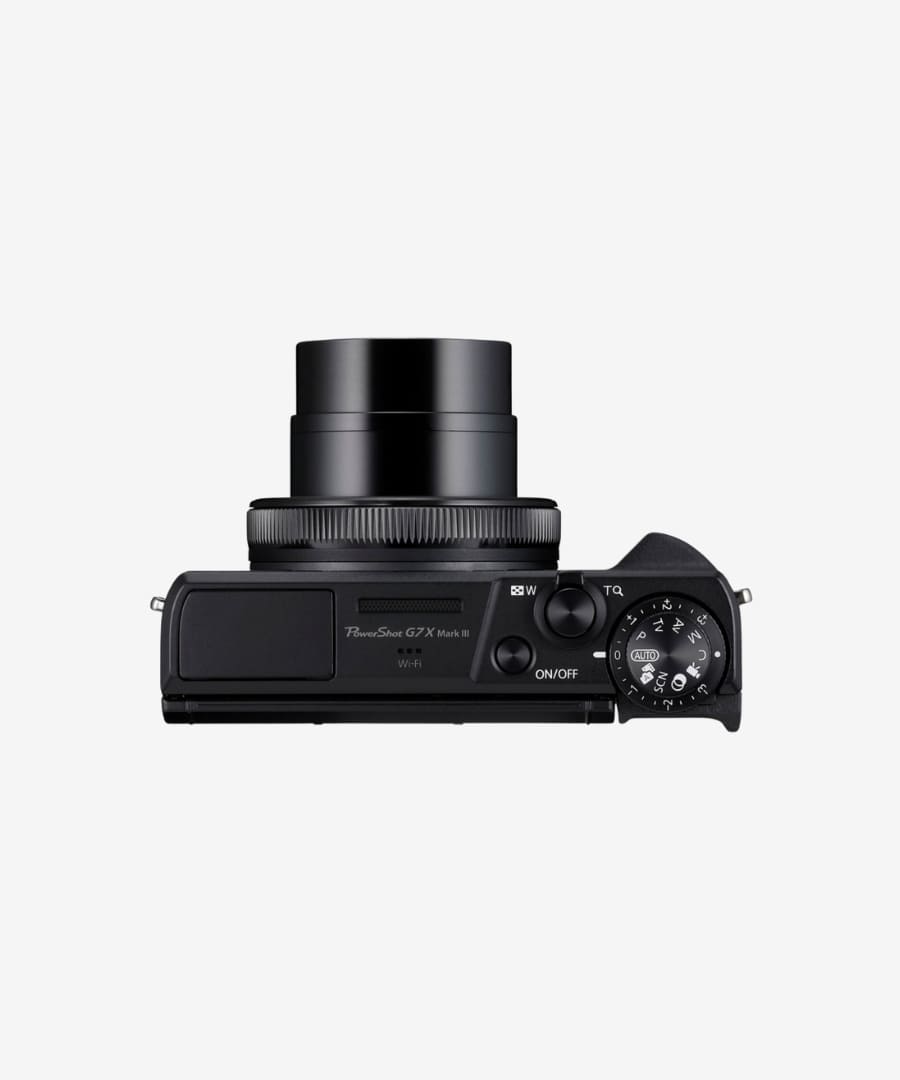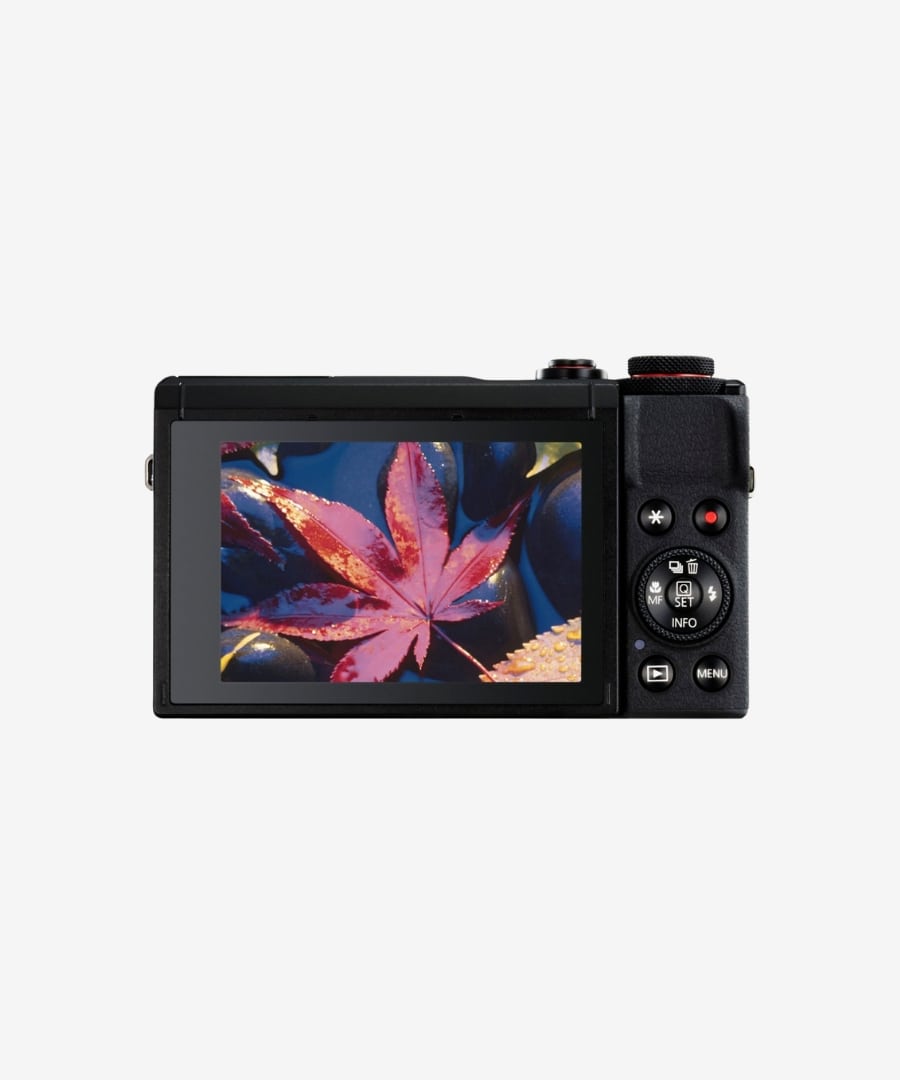The Canon PowerShot G7 X Mark III breaks new ground as the first camera with built-in live streaming capabilities. This feature could revolutionize content creation. This camera packs impressive specifications. Its fast 24-100mm F1.8-2.8 lens and 4K video recording at 30 frames per second make it a promising choice for vlogging. The 10-minute recording cap and 235-shot battery life need a closer look though.
Design and Build Quality
The Canon PowerShot G7 X Mark III feels premium the moment you pick it up. This compact camera measures 105.5 x 60.9 x 41.4mm and weighs just 304g with its battery and memory card installed.
The camera’s body blends metal and plastic elements seamlessly. A black leatherette wrap covers the body, which comes in black and silver options. Its well-designed handgrip makes it easier to hold than other models, especially compared to Sony RX100 III’s flat-front design.
Quality shows in every detail of this camera. The metal control ring around the lens moves smoothly and feels premium. The body’s rubberized plastic coating improves grip comfort. A sturdy plastic flap protects the input/output ports, while the battery and SD card compartment features a secure locking system.
Physical controls showcase excellent craftsmanship. The exposure compensation dial resists accidental changes with its firm movement. Each button gives satisfying feedback as it smoothly presses into the body. The LCD screen’s mechanism feels solid and reliable during use.
This PowerShot strikes an ideal balance between portability and capability. It fits easily in a pocket yet outperforms a smartphone by a wide margin. Red accents beneath the dials add a professional touch to its sophisticated look.
Ergonomics and Handling
The PowerShot G7 X Mark III shows careful attention to ergonomic design. Its sculpted, rubberized contact points give you a secure grip, and the camera feels comfortable in hand despite its compact size. A textured coating builds confidence during long shooting sessions.
Quick access and efficiency define the control layout. The control ring around the lens lets you customize functions like aperture control, ISO adjustment, and zoom settings. The top panel places essential controls within easy reach – including the mode dial, exposure compensation, and power button.
The responsive touchscreen system makes interface navigation simple. We designed the menu system to match Canon’s EOS DSLR layout, which helps Canon users feel at home. You can access frequently used settings through the Q-Menu button to streamline your shooting experience.
Each physical control gives excellent tactile feedback. The buttons travel smoothly into the body and prevent accidental activation. While slightly stiff, the exposure compensation dial maintains its position firmly during use.
Smart design choices enhance daily operation. The USB-C port handles both charging and power delivery, so you can use external power banks. The touch interface also lets you select focus points anywhere on screen with 49 AF points available, even in corners.
Physical controls and touch functionality work together naturally. The rear command dial gives quick access to focus, drive mode, and flash settings. Both the customizable movie record button and AE Lock button adapt to different shooting styles, adding flexibility to the control scheme.

Buttons Layout and customization
The PowerShot G7 X Mark III’s control scheme revolves around customization. A versatile front-mounted control ring lets photographers assign key functions like aperture control, ISO adjustment, and zoom settings.
You’ll find comprehensive shooting options on the mode dial. The TV mode controls shutter speed to create motion effects, AV mode manages aperture settings, and M mode gives you complete manual control. We designed the C mode to save your most-used settings, which includes shooting modes, menu setups, zoom positions, and manual focus priorities.
The star button helps you lock exposure settings to improve control in tricky lighting conditions. Your control ring’s functions change with each shooting mode and this affects what you can assign to the control dial.
Physical controls work seamlessly with a user-friendly touch interface. The camera remembers your settings even after switching modes or turning off the power. Quick exposure adjustments from -3 to +3 stops are possible with the exposure dial without menu navigation.
Canon added special button configurations for underwater photographers. You can set the star or movie button to “AF point selection” through Custom Functions. This helps adjust focus points even when touch controls aren’t available.
Canon users will feel right at home with the PowerShot G7 X Mark III’s interface since it matches the EOS DSLR layout. My Menu settings add more flexibility by letting photographers rename tabs and organize their frequently used functions.
Core Performance Features
The PowerShot G7 X Mark III comes with a 20.1-megapixel 1.0-inch stacked CMOS sensor and Canon’s DIGIC 8 processor that deliver remarkable performance. This camera excels at continuous shooting and captures up to 30 frames per second in RAW format for about 70 frames.
The contrast-detect autofocus system responds quickly in shooting scenarios of all types. Face detection works reliably and locks focus on subjects fast. You get three distinct AF area modes: Face + Tracking, Spot, and 1-point that give you flexibility in different shooting situations.
Raw shooting is a standout feature, as the camera keeps strong detail through ISO 1600. The processing engine handles noise well up to ISO 6400, where images stay usable with more visible grain. The camera produces clean images at lower ISOs that work great for everyday photography.
Video features showcase the processing power well. The G7 X Mark III records 4K/30p footage using the full sensor width and Full HD recording at up to 120 fps. The built-in 3-stop neutral density filter helps achieve video-friendly shutter speeds in bright conditions.
The camera’s processing speed shows in its buffer capacity, handling approximately:
- 89 frames in C-RAW format at 20 fps
- 55 frames in RAW format
- 118 frames in JPEG format
The autofocus system performs consistently in video mode but sometimes hunts for focus, which is typical of contrast-detect systems. Manual exposure control stays available throughout video recording, and you can use exposure compensation in Auto ISO mode to adjust brightness precisely.
Sensor and Image Quality
The PowerShot G7 X Mark III’s 20.1-megapixel 1-inch stacked CMOS sensor delivers impressive image quality in a variety of shooting conditions. This sensor, larger than those in smartphones and entry-level point-and-shoot cameras, captures strong detail with minimal noise through lower ISO settings.
Image quality remains consistently strong across the ISO range:
- ISO 125-800: Exceptional detail with negligible noise
- ISO 1600-3200: Good results with slight detail softening
- ISO 6400-12800: Increased noise but still usable for web content
- ISO 25600: Available but best avoided for critical work
JPEG images showcase vibrant colors and pleasing contrast straight out of camera. The sensor’s RAW capabilities give you additional flexibility by maintaining strong detail through ISO 1600. You can get usable results up to ISO 6400. The camera excels in both controlled and challenging lighting conditions.
The lens performance works well with the sensor capabilities. The camera achieves 1,716 lines on center-weighted evaluation at 24mm f/1.8. Resolution improves substantially at the midpoint zoom (50mm) and reaches 2,300 lines at f/2.5. The overall sharpness reaches its peak between f/4 and f/5.6 across the zoom range.
Real-life testing shows resilient dynamic range with good shadow recovery potential, especially when shooting RAW. The Auto Lighting Optimizer feature improves JPEG dynamic range effectively. Color reproduction stands out as a strength, and Canon’s signature color science ensures consistency across their camera lineup.

Lens Performance
PowerShot G7 X Mark III’s versatile lens combines a 24-100mm equivalent focal length with an impressive f/1.8-2.8 aperture range. Users can enjoy a 4.2x zoom range that works great for wide-angle landscapes and short telephoto portraits.
This lens packs 11 elements in 9 groups. Its construction features one double-sided aspherical lens, one single-sided aspherical UA lens, one single-sided aspherical lens, and one UD lens. Such a complex arrangement helps minimize distortion and chromatic aberration throughout the zoom range.
Resolution performance shows interesting variations across focal lengths:
- At 24mm f/1.8: The lens hits 1,716 lines on center-weighted evaluation
- At 50mm f/2.5: Quality jumps to 2,300 lines with edge sharpness reaching 1,940 lines
- At 100mm f/2.8: Performance starts at 1,650 lines and improves to 2,275 lines at f/5.6
The lens performs best in its mid-zoom range. Photographers will get the sharpest results by stopping down to f/4-5.6 across all focal lengths. Canon’s ZoomPlus technology can extend the optical zoom to offer 8.4x magnification.
Built-in optical image stabilization provides about 4 stops of shake correction. This system works with Intelligent IS that features 5-axis Advanced Dynamic IS and Auto Level capabilities. These combined technologies will give you steady shots even in difficult shooting conditions.
Processing and Responsiveness
The PowerShot G7 X Mark III excels at speed. The camera takes just 1.5 seconds from power-on to first shot, showing its quick response. Its mechanical shutter delivers quick autofocus – 0.149 seconds at wide-angle and 0.156 seconds at telephoto positions.
The stacked CMOS sensor design unlocks exceptional burst shooting abilities. The camera’s impressive speeds remain consistent:
- 30 fps in RAW burst mode for 76 frames
- 20 fps in standard continuous shooting for 125 JPEG frames
- 8.3 fps with continuous autofocus tracking
A fast SD card clears a full RAW burst in 9.2 seconds. You can adjust settings while the buffer clears, which adds flexibility. The camera captures prefocused shots with minimal shutter lag – just 0.024-second, perfect for split-second moments.
Shot-to-shot times stay under 0.3 seconds for both JPEG and RAW+JPEG combinations. The DIGIC 8 processor handles data well and keeps the camera running smoothly during long shoots. Face detection locks on quickly and keeps subjects in focus reliably.
The electronic shutter runs a bit slower than the mechanical one when shooting silently. The camera responds quickly to exposure changes and menu selections. Flash photography benefits from swift recycling times of 1.6 seconds.
Vlogging-Specific Features
The PowerShot G7 X Mark III shines with its impressive vlogging features. We designed this camera for content creators, and it brings live streaming directly to YouTube – making it the first compact camera in its class to do so. The camera also lets you record vertical videos perfect for Instagram content.
You’ll need these to stream with the camera:
- Active YouTube account with 1,000+ subscribers
- Valid image.canon account
- Firmware version 1.3.2 or later
The camera records 4K quality at 30 frames per second without any frame cropping. A firmware update added a dedicated vlogging mode that optimizes autofocus and exposure settings when you record yourself.
Vloggers will love the camera’s 3.5mm microphone input – a first for any one-inch compact camera. This port connects to external microphones that boost audio quality compared to the built-in mic.
The camera supports vertical video playback on iOS versions 9.3 through 12.2 and Android versions 5.0 through 9.0. You can use the clean HDMI output in 4K resolution for professional streaming setups right after setup.
The PowerShot G7 X Mark III makes vlogging easy with its flip-up touchscreen and customizable recording options. A red border appears around the frame during recording, so creators always know when they’re capturing content.

Flip-up Touchscreen
The 3.0-inch touchscreen display stands out as a defining feature of the PowerShot G7 X Mark III with its 1.04 million dots resolution. We designed this versatile screen with a biaxial tilt mechanism that rotates 180 degrees upward.
The touch panel responds quickly to menu navigation commands. Users can access camera settings through the Q-button menu and make quick adjustments with fingertips or the d-pad. The touch interface offers the quickest way to control settings, though users need precise finger placement due to compact selection boxes.
With 100% coverage of the image area, the screen helps photographers compose their shots accurately. The display shows clear images in normal conditions, but bright sunlight sometimes affects visibility. Touch controls make it easy to select focus points and navigate menus, which enhances the shooting experience.
The screen’s articulation mechanism works reliably to capture self-recordings. Touch sensitivity works perfectly even at extreme angles, and users maintain full control over settings while shooting from different angles. A 3:2 aspect ratio makes the screen ideal to view both photos and videos.
Capacitive touch technology combines with sRGB color reproduction to show accurate colors during image review and composition. Touch capabilities go beyond simple operations and support advanced features like touch-shutter release and touch-focus during video recording.
Built-in Microphone
The PowerShot G7 X Mark III shows impressive sound recording versatility. Users get manual audio control with fine-tuning options and a built-in limiter with wind reduction features. We designed the audio system for content creators that has visual monitoring through audio meters to make up for not having a headphone jack.
Manual audio mode gives sophisticated control over sound capture. This setting prevents noise from getting louder in quiet environments, unlike automatic gain control (AGC) systems that might make subtle camera sounds louder. The built-in microphone works well in noisy surroundings and captures clear audio even when acoustic conditions are challenging.
Recording conditions affect audio quality significantly. Voice reproduction from the internal microphone sounds somewhat thin outdoors. The camera has these audio control features:
- Manual level adjustment with visual meters
- Built-in wind reduction filter
- Audio limiter for preventing distortion
- Automatic gain control option
The built-in microphone works fine for casual recording, but serious content creators ended up preferring the 3.5mm microphone input. The camera works with external microphones of all types, from clip-on lavaliers to shotgun mics. The mounting options are limited because there’s no hot shoe.
The camera’s audio performance matches its vlogging focus and provides good quality for simple content creation. Wind noise becomes noticeable during outdoor sessions. Manual audio controls let users make precise adjustments to ensure optimal sound capture in different recording situations.
Live Streaming
The PowerShot G7 X Mark III stands out from traditional cameras with its direct YouTube streaming capability. We designed this feature with content creators in mind, though it needs specific requirements to work well:
- Active YouTube account with 1000+ subscribers
- Valid image.canon account
- Firmware version 1.3.2 or later
- Stable Wi-Fi connection
Creators with smaller audiences can use the EOS Webcam Utility instead. This software turns the camera into a high-quality webcam that works with Zoom, Skype, Facebook Live, Microsoft Teams, and Slack.
The camera’s streaming features go beyond simple live broadcasting by letting you schedule your live events. Canon’s dedicated streaming application makes setup easy by connecting straight to your Wi-Fi network.
Your streams won’t compromise on quality. The powerful 20MP CMOS sensor delivers uncropped video output during broadcasts. The camera supports USB-C charging while streaming, which helps during mobile sessions.
YouTube needs to verify your account before you can start streaming, which takes up to 24 hours. The live stream dashboard shows your streaming status once verified and lets you start broadcasting right away. You won’t need capture cards or extra hardware unless you specifically want HDMI output.

Video Performance
The PowerShot G7 X Mark III shows its true colors through its video capabilities. This camera records 4K/30p footage across the entire sensor width without cropping if you turn off movie IS or set it low. Your field of view slightly decreases if you enable higher stabilization levels.
4K Video Quality
Recording at 120 Mbps with 8-bit 4:2:0 color sampling, the 4K output delivers reliable exposure and good color reproduction. The footage quality lags behind competitors like the Sony RX100 V in detail capture. The G7 X III’s sensor sampling method and lens characteristics create this difference.
Frame Rate
Users can choose from these recording options:
- 4K at 29.97/25fps (10-minute limit)
- Full HD at 119.9/100/59.94/50/29.97/25 fps (30-minute limit)
- HD at 50fps
Internal temperature affects recording duration. The camera limits 4K mode to 10 minutes, and Full HD extends to 30 minutes. High frame rate recordings at 119.9fps run up to 7 minutes and 30 seconds.
Rolling Shutter
The electronic shutter is a vital component for high-speed capture, but it creates noticeable rolling shutter distortion. This becomes more obvious especially when you have:
- Fast-moving subjects crossing the frame
- Quick panning movements
- Shots under artificial lighting
The stacked sensor design helps reduce these effects, though some ‘jello effect’ remains visible with standard IS settings. You can minimize distortion by adjusting your shooting angle to 45 degrees relative to subject movement.
Advanced Stabilization
The PowerShot G7 X Mark III’s video system relies on its stabilization capabilities. This camera combines optical lens stabilization with digital IS modes and offers several levels of shake reduction.
Stabilization Modes
The stabilization system comes with these options:
- Off: No digital stabilization
- Low: Maintains full field of view
- Standard: Applies 1.11x crop
- High: Uses 1.43x crop factor
The optical stabilization reduces camera shake by about four stops. A smart Dual Sensing IS system looks at focal length, distance, and movement type to pick the best setting from seven possibilities. The Hybrid IS system handles both angular and directional movements, which helps keep macro shots steady.
Stabilization modes can substantially affect your image quality. The low setting keeps the original resolution intact, but standard and high modes make the image softer. Video quality gets worse as you increase stabilization levels, and this becomes quite obvious in high mode.
Tough conditions like 90-degree heat with direct sunlight put extra strain on the stabilization system. The camera’s CDAF system sometimes searches for focus and creates distracting moments in your footage. You should match your stabilization needs with video quality requirements because higher IS settings might reduce overall image clarity.
Audio
The PowerShot G7 X Mark III stands out with its audio capabilities. This compact camera features a 3.5mm microphone input – a first for cameras with 1-inch sensors.
Internal Microphone
The camera’s built-in microphone works well enough for casual recording and captures clear audio in controlled settings. Voice recordings tend to sound thin without much depth, especially when recording outdoors. Users might notice the microphone picks up operational sounds, including clicks from the lens control ring during recording.
External Microphone
Many microphones work with the 3.5mm input, ranging from wireless lavaliers to directional models. The Rode Wireless Go system has proven to be a popular choice among users who want better audio quality. The camera doesn’t have a hot shoe mount, so users need to get creative with microphone placement.

Audio Control
The PowerShot G7 X Mark III comes with a complete set of audio management tools:
- Manual level adjustment with visual monitoring
- Built-in wind noise reduction
- Audio limiter to prevent distortion
- Automatic gain control options
Some users have reported static problems in their recordings, even when using external microphones. The camera makes up for its lack of a headphone jack by providing on-screen audio level meters. Users can get better results in windy conditions by adding custom wind muffs over the internal microphones.
The audio system lets you switch between automatic and manual control modes. Manual mode works great at keeping unwanted noise down in quiet environments and gives you precise control over recording levels. Content creators who need broadcast-quality audio will find the external microphone support especially useful.
Battery Life and Power Management
The PowerShot G7 X Mark III’s power management is a vital feature to think about. The camera runs on the NB-13L battery pack and takes about 265 shots in standard mode. You can get up to 320 shots in ECO mode.
Battery life changes by a lot based on how you use the camera. You’ll get 55 minutes of video recording under CIPA-compliant conditions. We tested continuous shooting and got 90 minutes. The battery lasts an impressive 5 hours when just playing back content.
Charging Options
You can charge the camera through USB-C with the PD-E1 power adapter in about 110 minutes. The camera works directly through USB while shooting too. USB-C comes in handy during long streaming sessions and gives you non-stop power for extended recordings.
The PowerShot G7 X Mark III comes with several battery-saving features:
- Display auto-off timer that you can set up to 3 minutes
- ECO mode that gives you 20% more battery life
- Power saving priorities you can adjust
The camera’s power system adapts to different shooting needs. Long recording sessions need external power since the battery typically lasts 2.5 hours of non-stop use. Professional users usually carry spare batteries because 4K video recording and live streaming need lots of power.
Display power settings stay active even when Auto Power Off is off. Recent firmware updates have made USB power delivery better for long sessions. The camera offers many charging options that help maintain steady performance in any shooting situation.








